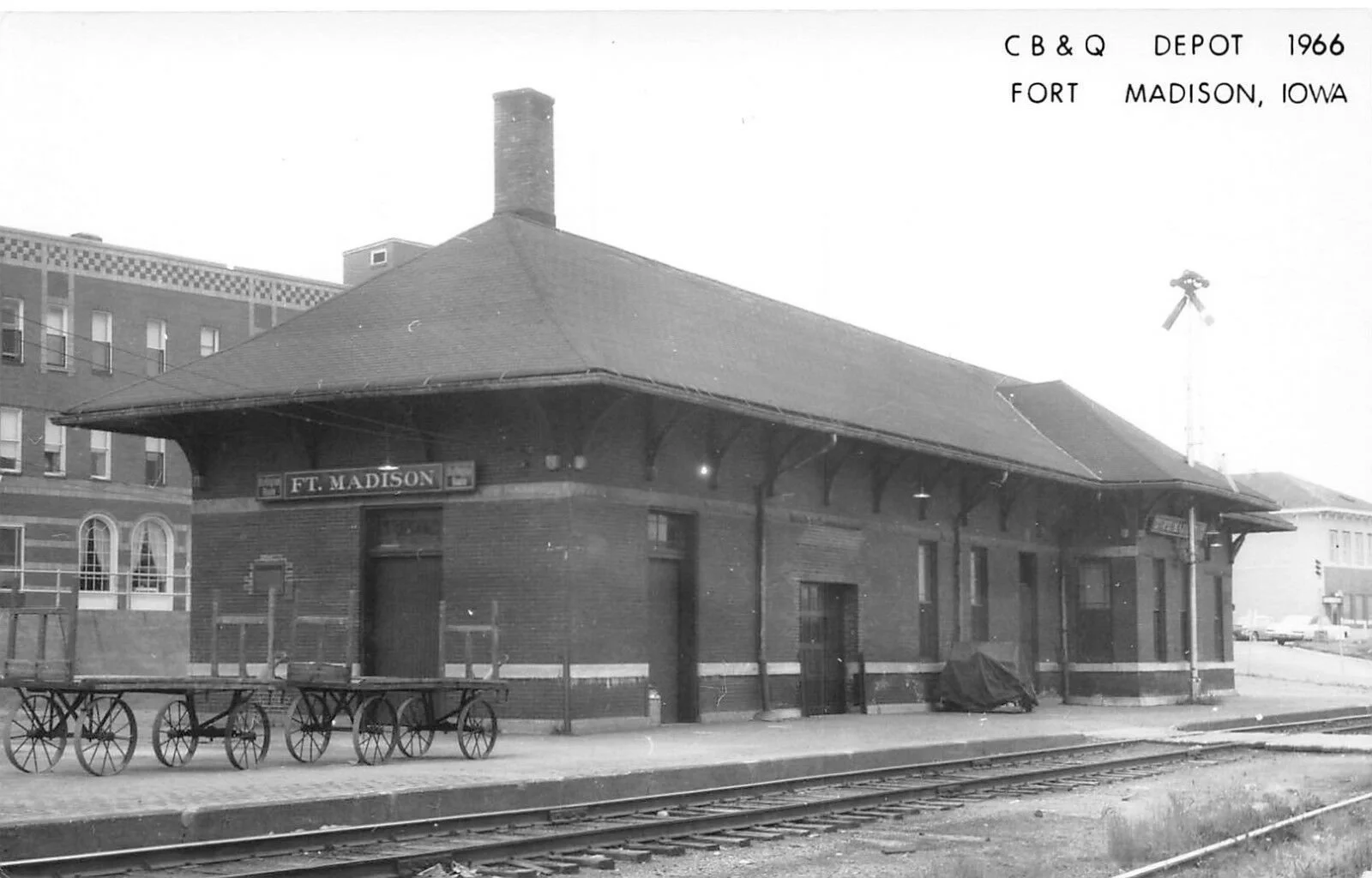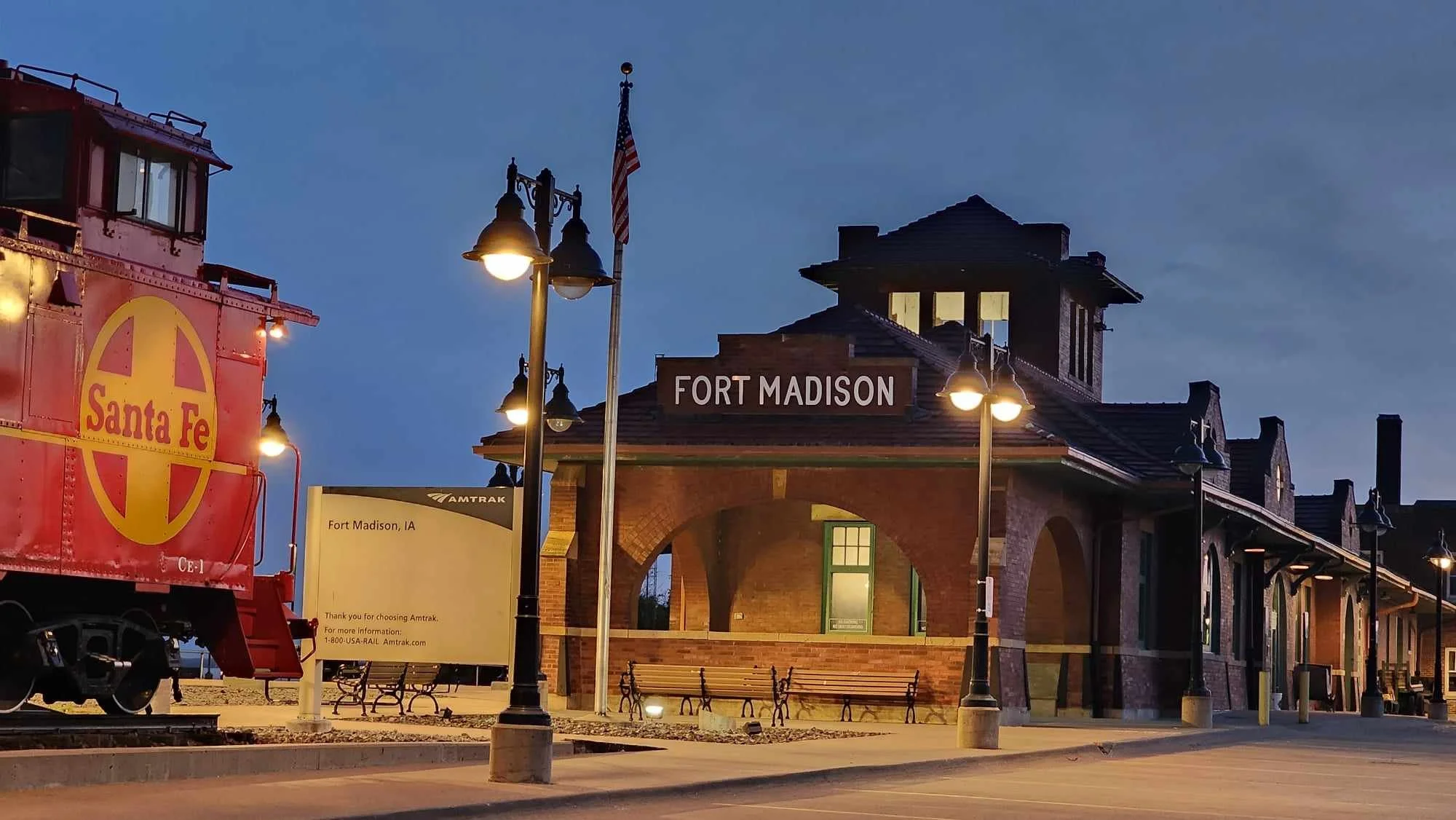HISTORIC SANTA FE DEPOT COMPLEX
Located at the foot of 9th Street with easy access from 10th Street and Avenue H, is the Atchison, Topeka & Santa Fe Passenger and Freight Complex Historic District, also known as the Historic Santa Fe Depot Complex. Placed on the National Register of Historic Places March 5th, 1992, it is the only Mission Style Depot in the state of Iowa. Fort Madison had embraed the railway system as it came into existence. Not only did our forefathers obtain a bridge charter in order to entice the rail system to Fort Madison, they also boarded the train of the Santa Fe Railway President Edison Payson Ripley on October 30th 1907. They wanted a better depot for travelers to utilize their community.
It was their lucky day! The Santa Fe Railway system had joined forces with Fred Harvey. Fred was an entrepreneur who had devolped a scheme for lunch rooms, restaurants, souvenir shops and hotels that catered to tourists traveling on the newly expanded rail services and taking adventurous folks to and from the west coast for the frist time in history. The Santa Fe Railway was big on tourism and wanted to make their stops attractive and pleasing to travelers. The blueprints and specificaitons were drawn up in September 1909. The Railway Age Gazette carried the news. Fort Madison would be home to a new brick veneer passenger depot in the Mission Style. At a cost of $14,000 the depot was constructed. It hosted a women’s waiting room, a general waiting room, a ticketing office, two agent’s offices, a baggage room and an express room. In 1922, the Railway Express Office was added at the west end, followed by the Santa Fe Freight Office in the early 1930s.
Transportation History in Iowa
When the Iowa Territories were fially grantee statehood in 1847, the United States was on the cusp of the Industrial and Transportaiton Revolution. From the mid 1800s to the turn of teh century, the US railways sprouted up all across the continental US. Through the bridging of the major waterways an the tracks that linked communities, the nation seemed to shrink in size almost over night. Prior to the introduction of teh railway system, the state of Iowa was limited to either horseback travel, animal drawn wagons or steamships and boats. With navigatable rivers acting as east and west borders, Iowa had thriving cities such as Fort Madison acting as ports along both the Mississippi and Missouri Rivers. The rivers that flowed from the interior of Iowa proved to be far too shallow and cumbersome for boat travel. With undeveloped roads and streets, transportation across the prairie lands of Iowa was tedious and time consuming. This fertile land was bringing in farmers, but ow would they move their products to market?
Birth of the Rail System
In 1854, the Rock Island Railroad finished the first rail system reaching the Mississippi River from Chicago. In anticipation of this event, small railroad companies started sprouting up in iowa as early as 1852. Iowa was anticipating the railway system’s imminent breach of the Mississippi River. There were four different lines that started their ourse fromte Mississippi towards the Missouri River by 1855. Congress, through the Land Grant of 1856, granted over two million acres of federal land to Iowa for the construction of railroads. Even with this grant of lands, the railway system grew slowly, due to the lack of materials. After all, free land was one thing, butthe goods to build the railway system still requred funds in order to be completed. The financial panic of 1857 resulted n even less available capital to fund teh rail system. iowa’s total mileage of the tracks laid by this time was only 130 miles. It wasn’t until 1869 that connection from the Mississippi River to the Missourim River was complete. By 1914, Iowa had more than 10,000 miles of track, with nearly every city, town and hamlet reachable by steam train or electric trolley systems.
Railways in Fort Madison - The Chicago, Burlington & Quincy Railway (CB&Q)
In the late 1860’s, a rail connection was made with Keokuk and 20 miles south along the Mississippi Rver. This became part of the Chicago, Burlington and Quincy Railroad (CB&Q) in 1869. The CB&Q got it’s start on Septemer 2, 1850 when their first train chugged its way over only six miles of track. By the time it was absorbed ino the Burlington Northern Railraod in the 1970s, the railway had tracks that linked the three communities that were its namesake, along with many more. Remnants of this early railraod live on today in the name Burlington Northern Santa Fe (BNSF), which operates most all rail service within the continental U.S. and Canada. The 1998 CB&Q Depot is available to visitors to visit. It houses Fort Madison’s transportation history, covering the rail system, as well as river travel, commerce and the Fort Madison Swing-Span Bridge.
Bridging the Mississippi
In the mid 1880s, the Santa Fe decided to extend easward towards Chicago from it’s home base in Kansas. A major challenge was the bridging of the Mississippi River. Fort Madison had put in place mulitiple items that swayed Santa Fe to cross at their location in the form of a bridge charter, tax reductions and land for the railraods’ switchyards and shops, securing them the newest Mississippi River crossing in 1887. An influx of Santa Fe Railway workers resulted in the town being nicknamed “Boom Town”. The city was ill prepared. The town’s newspaper The Weekly Democrat noted: “Local citizens were slow to control wandering cattle in town who pirouette about the city parks and rush pell-mell through the streets.” The bridge was designed by Octave Chanute, an engineer whose theory of flying machines inspired Orville & Wilbur Wright’s first ever flying machine. Chanute started work on the structure’s timber pilings and masonry piers in April of 1887, completing theh 1,925 foot bridge by December of that same year. The original bridge consisted of an eight-span, single track passing through a truss bridge. A wagon lane jutting off the side, was held in place by brackets outside the trusss, making for a heart stopping crossing for wagons, foot traffic, bicycles and horseman. The original bridge was replaced forty years later. It could no longer safely sustain teh increasingly heavy traffic loads and the increasing size of the locomotives and railcars. In 1925, work started on the current bridge. Designed by A.F. Robinson of the Santa Fe Railroad.
The current Fort Madison Toll Bridge is considered the longest double-deck swing-span bridge in the world. Amtrak’s Southwest Chief crosses it on the way to and from Chicago to Los Angeles on the west coast. The structure consists of a riveted double track, double decker swing through truss, a nine-span deck girder on the Illinois approach, and a ten-span deck girder on the west approach and a 525 foot swing span. The bridge was built with 29 million pounds of meta and 46,000 cubic yards of concrete at a total cost of $5.5 million, and was formally opened to traffic on July 28, 1927. The 525 foot electrified swing span was the longest and heaviest in the country at the time it was built. River traffic, which has the right of way, results in the swing span being opened approximately 2,000 tiems annually. A typical opening of the bridge is to allow a tow with 15 barges through. The average length of time required is 15 to 20 minutes. Riverboats and barges tend to draw onlookers to Fort Madison’s Riverview Park, where they can watch them pass through the 525 foot opening.
ATCHISON, TOPEKA AND SANTA FE
STEAM ENGINE #2913
Followig WWII, the railway systems in the United States started developing newer, more cost effective engines. They also slowly moved away from the use of way cars (also known as cabooses) on trains. The smaller railway systems were swallowed up by the bigger names. Now the Burlington Northern Santa Fe Railroad, more informally known as the BNSF, is the major railway system in the United States. It was aroudn the 1950s that the then AT&SF Railway gifted Fort Madison with both a Steam Engine and a Way Car. Steam Engine 2913 is located in Riverview Park. It was gifted to the City of Fort Madison on the 72nd anniversary of the Santa Fe’s first through train to Chicago from Kansas City. The 708,000 pound engine, which was built in 1944, had been used to haul war equipment in the western United States.
Santa Fe Caboose #235
Donated to the North Lee County Historical Society, the way car has been restored and includes the brakemen seats, conductor’s desk, folding seat/bed, and a cast iron stove. Nearby, more than 80 freight trains a day still pass through Fort Madison, making our town a must see for all railroad enthusiasts!
ATSF DEPOT
The Atchison, Topeka and Santa Fe Passenger and Freight Complex is a nationally recognized historic district in Fort Madison, Iowa, listed on the National Register of Historic Places since 1992. The district, featuring three significant buildings constructed over a 24-year span, reflects the architectural styles of their respective eras.
The complex includes:
The 1910 Passenger Depot: Designed by C.F. Morse in the Mission Revival style, this single-story brick building, originally serving both passenger and freight needs, was adapted from the railroad’s "county-seat" standard. It boasts a distinctive red tile hipped roof and Appanoose stone detailing. A 1945 renovation introduced Art Deco elements, including the removal of the women’s waiting room.
The 1922 Railway Express Agency (REA): Designed by J.M. Dunham, this building also features Mission Revival architecture but with distinct copper detailing that was later removed in a 1990 renovation. It complements the passenger depot with its pressed brick and stone trim.
The 1934 Division Freight Office (DFO): Located west of the Railway Express Office, this two-story brick structure is more utilitarian in design, featuring the Santa Fe logo in stone on its elevations. It served as a crucial part of the railroad’s operations, including facilities where crew could take a nap and wash up.
The complex, once a key stop on the Santa Fe Railway's only Iowa route and a hub for locomotive repairs, now hosts the North Lee County Historical Society, the Fort Madison Tourism Bureau, and the Fort Madison Amtrak ticket office. The original passenger depot was replaced by the Amtrak station in 1968, and service returned to the restored station in 2021.
CB&Q DEPOT
Located just north of the Santa Fe complex, the former Chicago, Burlington and Quincy (CB&Q) Fort Madison station is not included in the historic district. Built in 1898, this station now serves as the North Lee County Historical Society Transportation Museum. It was affected by the 2019 flooding since it was not included in the project to elevate the Santa Fe station's foundation. The single track running through the area is part of the Hannibal Subdivision, also known as the "K Line," and is owned by BNSF Railway.
Raising the Santa Fe Depot
In 2011, a century after its original construction, the Fort Madison, Iowa, Historic 1910 Santa Fe Depot Complex was elevated by four feet, three inches to protect it from frequent floods caused by the Mississippi River. This time-lapsed video captures the elevation process for all three buildings in the complex. Today, the revitalized complex houses the Fort Madison Amtrak Station, the North Lee County Historical Society, and the Fort Madison Tourism Bureau.










